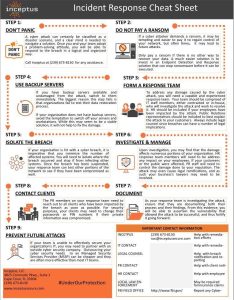Incident Response Cheat Sheet by TheMadAdmin (AKA Dave)
Step 1: Don’t Panic
- Stay calm and adopt a problem-solving attitude. This will help you and your team respond logically and effectively to the breach.
Step 2: Do Not Pay a Ransom
- Paying ransom often leads to more trouble. Invest in an Endpoint Detection and Response solution to handle ransomware before it executes.
Step 3: Form a Response Team
- Assemble a capable response team including IT staff, HR, and PR. They will investigate, address the breach, and manage communications.
Step 4: Use Backup Servers
- If available, switch to backup servers to maintain operations. Ensure your backups are tested regularly.
Step 5: Isolate the Breach
- Minimize the number of affected systems by isolating the breached area. Test other network segments to ensure they are secure.
Step 6: Investigate & Manage
- Investigate the breach to understand the damage. Address any impacts, especially on employees and your company’s reputation.
Step 7: Document
- Document the breach and your response thoroughly. This helps in refining your response strategy and future prevention.
Step 8: Contact Clients
- Notify affected clients promptly and provide them with necessary information, especially if their private data was compromised.
Step 9: Prevent Future Attacks
- Consider partnering with an external cybersecurity firm if your team struggles with securing your IT infrastructure. Managed Security Services Providers (MSSPs) can be more efficient.
Important Contact Information:
- IT Contact: For remediation efforts
- Legal Counsel: For breach notification and reporting
- PR Contact: For client notifications
- HR Contact: For employee impacts
- Local Law Enforcement: May be needed for insurance claims
- FBI Field Office: www.fbi.gov – Report cyber crimes
Why You Need an Incident Response Policy
Having a written Incident Response policy is crucial as it ensures your organization is prepared for cybersecurity incidents. This policy:
- Provides clear steps to manage and mitigate breaches, minimizing damage.
- Ensures all team members understand their roles and responsibilities.
- Helps maintain client trust by demonstrating a proactive approach to security.
- Assists in regulatory compliance and reduces potential legal liabilities.
Prepared by: TheMadAdmin (AKA Dave)
Having a well-documented policy helps your team stay organized and effective during a crisis, ensuring a swift and controlled response.


